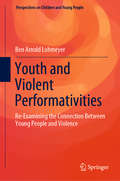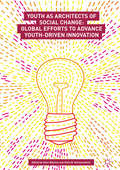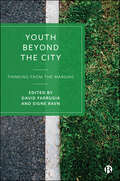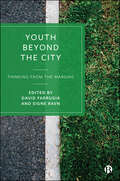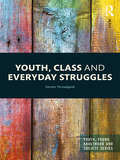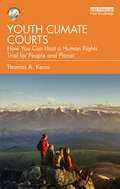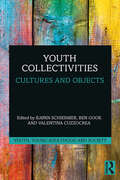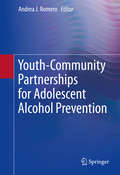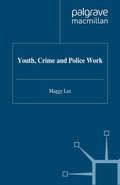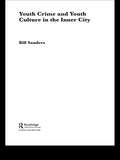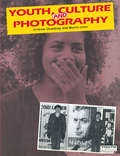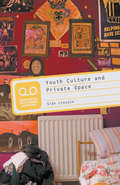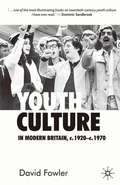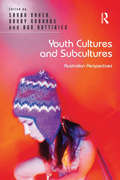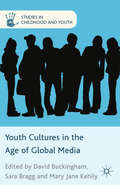- Table View
- List View
Youth and Violent Performativities: Re-Examining the Connection Between Young People and Violence (Perspectives on Children and Young People #11)
by Ben Arnold LohmeyerThis book challenges the dominant narrative of young people being a uniquely violent group. Instead, the book critically examines how young people become violent as they enact and resist the available violent performativities in youth. It focuses on the experiences of 28 young people in Australia who are subjected to violence, who use violence and who resist violence. A critical analysis of these young people’s “messy” stories facilitates a reframing of the physical violence routinely attributed to young people as a product of violating systems and structures. The author constructs a converging theoretical landscape to re-examine youth, violence and resistance at the intersection of the sociology of violence and the sociology of youth. Drawing on interviews with young Australians, the book makes a valuable contribution to contemporary international scholarship on youth and violence, while also examining the potential for complicity to violence in youth research and practice. In doing so it offers youth scholars and practitioners a framework for reassessing their theoretical frameworks and methods for studying and working with young people in connection with violence.
Youth as Architects of Social Change: Global Efforts to Advance Youth-Driven Innovation
by Sheri Bastien Halla B. HolmarsdottirThis edited collection outlines the issues central to youth engagement in research and social innovation. Youth-driven innovation for social change is increasingly recognized as holding potential for the development of sustainable strategies to tackle some of the most pressing global challenges of our time. The contributors provide additional knowledge concerning what actually constitutes an enabling environment, as well as the most effective approaches for engaging youth as architects of change. While sensitive to the need for contextual appropriateness, the volume contributes to the development of shared understandings and frameworks for engaging and spurring youth-driven innovation for social change worldwide. Youth-Driven Social Innovation showcases examples of youth engagement in frugal and reverse innovation worldwide, alongside examples which demonstrate the tremendous potential of South-South learning, but also learning and youth innovation in the Global North. It will be of interest to students and scholars across a range of disciplines including education, sociology, anthropology, public health, and politics.
Youth as Architects of Social Change: Global Efforts to Advance Youth-Driven Innovation
by Sheri Bastien Halla B. HolmarsdottirThis edited collection outlines the issues central to youth engagement in research and social innovation. Youth-driven innovation for social change is increasingly recognized as holding potential for the development of sustainable strategies to tackle some of the most pressing global challenges of our time. The contributors provide additional knowledge concerning what actually constitutes an enabling environment, as well as the most effective approaches for engaging youth as architects of change. While sensitive to the need for contextual appropriateness, the volume contributes to the development of shared understandings and frameworks for engaging and spurring youth-driven innovation for social change worldwide. Youth-Driven Social Innovation showcases examples of youth engagement in frugal and reverse innovation worldwide, alongside examples which demonstrate the tremendous potential of South-South learning, but also learning and youth innovation in the Global North. It will be of interest to students and scholars across a range of disciplines including education, sociology, anthropology, public health, and politics.
Youth Beyond the City: Thinking from the Margins
by David Farrugia and Signe RavnThis interdisciplinary collection charts the experiences of young people in places of spatial marginality around the world, dismantling the privileging of urban youth, urban locations and urban ways of life in youth studies and beyond. Expert authors investigate different dimensions of spatiality including citizenship, materiality and belonging, and develop new understandings of the complex relationships between place, history, politics and education. From Australia to India, Myanmar to Sweden, and the UK to Central America, international examples from both the Global South and North help to illuminate wider issues of intergenerational change, social mobility and identity. By exploring young lives beyond the city, this book establishes different ways of thinking from a position of spatial marginality.
Youth Beyond the City: Thinking from the Margins
by David Farrugia Signe RavnThis interdisciplinary collection charts the experiences of young people in places of spatial marginality around the world, dismantling the privileging of urban youth, urban locations and urban ways of life in youth studies and beyond. Expert authors investigate different dimensions of spatiality including citizenship, materiality and belonging, and develop new understandings of the complex relationships between place, history, politics and education. From Australia to India, Myanmar to Sweden, and the UK to Central America, international examples from both the Global South and North help to illuminate wider issues of intergenerational change, social mobility and identity. By exploring young lives beyond the city, this book establishes different ways of thinking from a position of spatial marginality.
Youth, Class and Everyday Struggles (Youth, Young Adulthood and Society)
by Steven ThreadgoldThe concept of everyday struggles can enliven our understanding of the lives of young people and how social class is made and remade. This book invokes a Bourdieusian spirit to think about the ways young people are pushed and pulled by the normative demands directed at them from an early age, whilst they reflexively understand that allegedly available incentives for making the ‘right’ choices and working hard – financial and familial security, social status and job satisfaction – are a declining prospect. In Youth, Class and Everyday Struggles, the figures of those classed as 'hipsters' and 'bogans' are used to analyse how representation works to form a symbolic and moral economy that produces and polices fuzzy class boundaries. Further to this, the practices of young people around DIY cultures are analysed to illustrate struggles to create a satisfying and meaningful existence while negotiating between study, work and creative passions. By thinking through different modalities of struggles, which revolve around meaning making and identity, creativity and authenticity, Threadgold brings Bourdieu’s sociological practice together with theories of affect, emotion, morals and values to broaden our understanding of how young people make choices, adapt, strategise, succeed, fail and make do. Youth, Class and Everyday Struggles will appeal to undergraduate and postgraduate students, as well as postdoctoral researchers, of fields including: Youth Studies, Class and Inequality, Work and Careers, Subcultures, Media and Creative Industries, Social Theory and Bourdieusian Theory.
Youth, Class and Everyday Struggles (Youth, Young Adulthood and Society)
by Steven ThreadgoldThe concept of everyday struggles can enliven our understanding of the lives of young people and how social class is made and remade. This book invokes a Bourdieusian spirit to think about the ways young people are pushed and pulled by the normative demands directed at them from an early age, whilst they reflexively understand that allegedly available incentives for making the ‘right’ choices and working hard – financial and familial security, social status and job satisfaction – are a declining prospect. In Youth, Class and Everyday Struggles, the figures of those classed as 'hipsters' and 'bogans' are used to analyse how representation works to form a symbolic and moral economy that produces and polices fuzzy class boundaries. Further to this, the practices of young people around DIY cultures are analysed to illustrate struggles to create a satisfying and meaningful existence while negotiating between study, work and creative passions. By thinking through different modalities of struggles, which revolve around meaning making and identity, creativity and authenticity, Threadgold brings Bourdieu’s sociological practice together with theories of affect, emotion, morals and values to broaden our understanding of how young people make choices, adapt, strategise, succeed, fail and make do. Youth, Class and Everyday Struggles will appeal to undergraduate and postgraduate students, as well as postdoctoral researchers, of fields including: Youth Studies, Class and Inequality, Work and Careers, Subcultures, Media and Creative Industries, Social Theory and Bourdieusian Theory.
Youth Climate Courts: How You Can Host a Human Rights Trial for People and Planet
by Thomas A. KernsThis book focuses on Youth Climate Courts, a bold new tool that young people in their teens and twenties can use to compel their local city or county government to live up to its human rights obligations, formally acknowledge the climate crisis, and take major steps to address it. Tom Kerns shows how youth climate leaders can form their own local Youth Climate Court, with youth judges, youth prosecuting attorneys, and youth jury members, and put their local city or county government on trial for not meeting its human rights obligations. Kerns describes how a Youth Climate Court works, how to start one, what human rights are, what they require of local governments, and what governmental changes a Youth Climate Court can realistically hope to accomplish. The book offers young activists a brand new, user-friendly, cost-free, barrier-free, powerful tool for forcing local governments to come to terms with their obligation to protect the rights of their citizens with respect to the climate crisis. This book offers a unique new tool to young climate activists hungry for genuinely effective ways to directly move governments to aggressively address the climate crisis.
Youth Climate Courts: How You Can Host a Human Rights Trial for People and Planet
by Thomas A. KernsThis book focuses on Youth Climate Courts, a bold new tool that young people in their teens and twenties can use to compel their local city or county government to live up to its human rights obligations, formally acknowledge the climate crisis, and take major steps to address it. Tom Kerns shows how youth climate leaders can form their own local Youth Climate Court, with youth judges, youth prosecuting attorneys, and youth jury members, and put their local city or county government on trial for not meeting its human rights obligations. Kerns describes how a Youth Climate Court works, how to start one, what human rights are, what they require of local governments, and what governmental changes a Youth Climate Court can realistically hope to accomplish. The book offers young activists a brand new, user-friendly, cost-free, barrier-free, powerful tool for forcing local governments to come to terms with their obligation to protect the rights of their citizens with respect to the climate crisis. This book offers a unique new tool to young climate activists hungry for genuinely effective ways to directly move governments to aggressively address the climate crisis.
Youth Collectivities: Cultures and Objects (Youth, Young Adulthood and Society)
by Bjø Schiermer Ben Gook Valentina CuzzocreaThis volume seeks to address what its contributors take to be an important lacuna in youth cultural research: a lack of interest in the phenomenon of collectivity and collective aspects of youth culture. It gathers scholars from diverse research backgrounds – ranging from contemporary subculture studies, fan culture studies, musicology, youth transitions studies, criminology, technology and work-life studies – who all address collective phenomena in young lives. Ranging thematically from music experience and festival participation, via soccer fan culture, leisure, street art, youth climate activism, to the design of EU youth policies and Australian government ‘project’ work with young migrants, the chapters develop a variety of approaches to collective aspects to young cultural practices and material cultures. To establish these new approaches, the contributors combine new theories and fresh empirical work; they critically engage with the tradition and they complement or even reconfigure traditional approaches in and around the field. The book will be of interest to researchers in a broad range of areas in and around the field of youth culture studies including post-subculture studies, cultural studies, musicology, fan-culture and youth transition research, but it is also of acute interest for theoretically interested sociologists. The volume offers a new afterword by French sociologist Michel Maffesoli.
Youth Collectivities: Cultures and Objects (Youth, Young Adulthood and Society)
by Bjørn SchiermerThis volume seeks to address what its contributors take to be an important lacuna in youth cultural research: a lack of interest in the phenomenon of collectivity and collective aspects of youth culture. It gathers scholars from diverse research backgrounds – ranging from contemporary subculture studies, fan culture studies, musicology, youth transitions studies, criminology, technology and work-life studies – who all address collective phenomena in young lives. Ranging thematically from music experience and festival participation, via soccer fan culture, leisure, street art, youth climate activism, to the design of EU youth policies and Australian government ‘project’ work with young migrants, the chapters develop a variety of approaches to collective aspects to young cultural practices and material cultures. To establish these new approaches, the contributors combine new theories and fresh empirical work; they critically engage with the tradition and they complement or even reconfigure traditional approaches in and around the field. The book will be of interest to researchers in a broad range of areas in and around the field of youth culture studies including post-subculture studies, cultural studies, musicology, fan-culture and youth transition research, but it is also of acute interest for theoretically interested sociologists. The volume offers a new afterword by French sociologist Michel Maffesoli.
Youth-Community Partnerships for Adolescent Alcohol Prevention
by Andrea J. RomeroThis forward-thinking reference spotlights an expansive and inclusive community model for youth alcohol prevention as opposed to traditional individual and school-based group approaches. Focusing on a long-term intervention in a Southwestern border town, it documents the development of critical consciousness in an affected community, and emphasizes young people as crucial drivers of change in their environment. The book’s Community Readiness Model provides vital context for successful coalition building between youth, families, and community entities (e.g., schools, civic leaders, police) in reducing alcohol risk factors and promoting healthier choices. Given the severity and prevalence of youth alcohol use, this case study offers a viable blueprint for large-scale engagement in prevention. Among the featured topics: Integrating research into prevention strategies using participatory action research. Breaking down silos between community-based organizations: coalition development. Adult perspectives on nurturing youth leadership and coalition participation. Youth perspectives on youth power as the source of community development. Coalition as conclusion: tips on creating a functioning coalition. Community transformational resilience for adolescent alcohol prevention. Youth-Community Partnerships for Adolescent Alcohol Prevention is both practical and inspiring reading for researchers and other mental health professionals in psychology, social work, and public health who work with adolescents, communities, and civic engagement.
Youth, Crime and Justice
by Cyndi BanksYouth, Crime and Justice takes a critical issues approach to analyzing the current debates and issues in juvenile delinquency. It encourages readers to adopt an analytical understanding encompassing not only juvenile crime, but also the broader context within which the conditions of juvenile criminality occur. Students are invited to explore the connections between social, political, economic and cultural conditions and juvenile crime. This book engages with the key topics in the debate about juvenile justice and delinquency: juvenile institutions delinquency theories gender and race youth and moral panic restorative justice youth culture and delinquency. It clearly examines all the important comparative and transnational research studies for each topic. Throughout, appropriate qualitative studies are used to provide context and explain the theories in practice, conveying a powerful sense of the experience of juvenile justice. This accessible and innovative textbook will be an indispensable resource for senior undergraduates and postgraduates in criminology, criminal justice and sociology.
Youth, Crime and Justice
by Cyndi BanksYouth, Crime and Justice takes a critical issues approach to analyzing the current debates and issues in juvenile delinquency. It encourages readers to adopt an analytical understanding encompassing not only juvenile crime, but also the broader context within which the conditions of juvenile criminality occur. Students are invited to explore the connections between social, political, economic and cultural conditions and juvenile crime. This book engages with the key topics in the debate about juvenile justice and delinquency: juvenile institutions delinquency theories gender and race youth and moral panic restorative justice youth culture and delinquency. It clearly examines all the important comparative and transnational research studies for each topic. Throughout, appropriate qualitative studies are used to provide context and explain the theories in practice, conveying a powerful sense of the experience of juvenile justice. This accessible and innovative textbook will be an indispensable resource for senior undergraduates and postgraduates in criminology, criminal justice and sociology.
Youth, Crime and Policework
by M. LeeFrom the running of boys' clubs and catching truants to supervising troublesome kids and giving them a 'clip round the ear', the role of the police has been a recurrent theme in the debate about juvenile delinquency. Set against the context of wider developments in youth justice in Britain, this book examines the origins, key features and outcomes of police work with young people, the realities of multi-agency decision-making, and the impact on young people and their families.
Youth Crime and Youth Culture in the Inner City (Routledge Advances in Sociology)
by Bill SandersYouth Crime and Youth Culture in the Inner City offers an interpretive account of juvenile delinquency within the modern inner city, an environment which is characterized by a long history of social deprivation and high rates of crime. A wide range of topics are explored, such as young people's motivation for, frequency of, and attitudes towards, a variety of illegal behaviors, such as street robbery, burglary, theft, drug use, drug selling and violence. Why do young people commit these offences? Who do they commit them against? How do they feel afterwards? This book attempts to answer these important theoretical questions, utilizing ethnographic research collected over a seven year period and based around the London inner city borough of Lambeth.
Youth Crime and Youth Culture in the Inner City (Routledge Advances in Sociology)
by Bill SandersYouth Crime and Youth Culture in the Inner City offers an interpretive account of juvenile delinquency within the modern inner city, an environment which is characterized by a long history of social deprivation and high rates of crime. A wide range of topics are explored, such as young people's motivation for, frequency of, and attitudes towards, a variety of illegal behaviors, such as street robbery, burglary, theft, drug use, drug selling and violence. Why do young people commit these offences? Who do they commit them against? How do they feel afterwards? This book attempts to answer these important theoretical questions, utilizing ethnographic research collected over a seven year period and based around the London inner city borough of Lambeth.
Youth Culture and Private Space
by S. LincolnSiân Lincoln considers the use, role and significance of private spaces in the lives of young people. Drawing on extensive ethnographic research, she explores the place of 'the private' in youth cultural discourses, both historically and contemporarily, that until now have remained largely absent in youth cultural research.
Youth Culture and Social Change: Making a Difference by Making a Noise (PDF) (Palgrave Studies in the History of Subcultures and Popular Music)
by John Street Peter Webb Lucy Robinson Matthew Worley Keith Gildart Anna Gough-Yates Sian Lincoln Bill OsgerbyThis book brings together historians, sociologists and social scientists to examine aspects of youth culture. The book’s themes are riots, music and gangs, connecting spectacular expression of youthful disaffection with everyday practices. By so doing, Youth Culture and Social Change maps out new ways of historicizing responses to economic and social change: public unrest and popular culture.
Youth Culture In Modern Britain, C. 1920-c. 1970 (PDF)
by W. Fowler David FowlerThis book traces the history of youth culture from its origins among the student communities of inter-war Britain to the more familiar world of youth communities and pop culture. Grounded in extensive original research, it explores the individuals, institutions and ideas that have shaped youth culture over much of the twentieth century.
Youth Cultures and Subcultures: Australian Perspectives
by Brady Robards Sarah BakerThis volume critically examines ’subculture’ in a variety of Australian contexts, exploring the ways in which the terrain of youth cultures and subcultures has changed over the past two decades and considering whether ’subculture’ still works as a viable conceptual framework for studying youth culture. Richly illustrated with concrete case studies, the book is thematically organised into four sections addressing i) theoretical concerns and global debates over the continued usefulness of subculture as a concept; ii) the important place of ’belonging’ in subcultural experience and the ways in which belonging is played out across an array of youth cultures; iii) the gendered experiences of young men and women and their ways of navigating subcultural participation; and iv) the ethical and methodological considerations that arise in relation to researching and teaching youth culture and subculture. Bringing together the latest interdisciplinary research to combine theoretical considerations with recent empirical studies of subcultural experience, Youth Cultures and Subcultures will appeal to scholars and students across the social sciences.
Youth Cultures and Subcultures: Australian Perspectives
by Brady Robards Sarah BakerThis volume critically examines ’subculture’ in a variety of Australian contexts, exploring the ways in which the terrain of youth cultures and subcultures has changed over the past two decades and considering whether ’subculture’ still works as a viable conceptual framework for studying youth culture. Richly illustrated with concrete case studies, the book is thematically organised into four sections addressing i) theoretical concerns and global debates over the continued usefulness of subculture as a concept; ii) the important place of ’belonging’ in subcultural experience and the ways in which belonging is played out across an array of youth cultures; iii) the gendered experiences of young men and women and their ways of navigating subcultural participation; and iv) the ethical and methodological considerations that arise in relation to researching and teaching youth culture and subculture. Bringing together the latest interdisciplinary research to combine theoretical considerations with recent empirical studies of subcultural experience, Youth Cultures and Subcultures will appeal to scholars and students across the social sciences.
Youth Cultures in a Globalized World: Developments, Analyses and Perspectives
by Hannes Krall Gerald KnappThis book examines the relation between the phenomenon of globalization, changes in the lifeworld of young people and the development of specific youth cultures. It explores the social, political, economic and cultural impact of globalization on young people. Growing diversity in their lifeworlds, technological development, migration and the ubiquity of digital communication and representation of the world open up new forms of self-representation, networking and political expression, which are described and discussed in the book. Other topics are the impact of globalization on work and economy, global environmental issues such as climate change, political movements which put “nationalism first”, change of youth`s values and the significance of body, gender and beauty. The book highlights the challenges of young people in modern life, as well as the way in which they express themselves and engage in society – in culture, politics, work and social life.
Youth Cultures in the Age of Global Media (Studies in Childhood and Youth)
by Mary Jane Kehily Sara BraggThis book explores the impact of globalisation and new technologies on youth cultures around the world, from the Birmingham School to the youthscapes of South Korea. In a timely reappraisal of youth cultures in contemporary times, this collection profiles the best of new research in youth studies written by leading scholars in the field.
